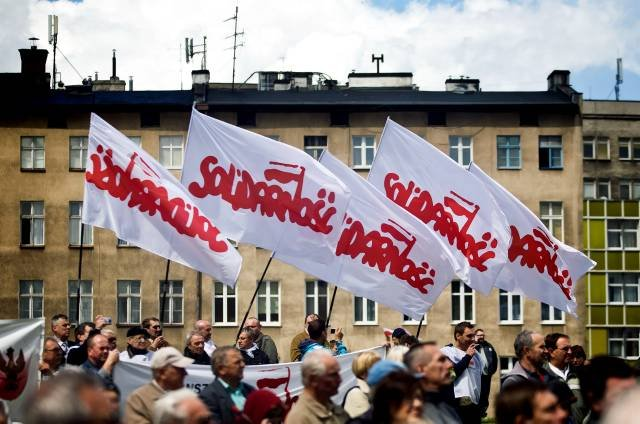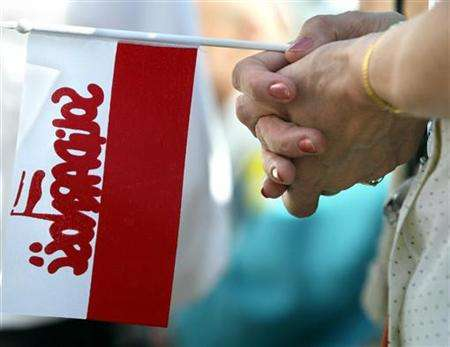Note: If an image ever fails to appear - refresh your page, it really is there
The End of the People's Republic
by Chrystian Kretowicz and Peter Loeser
|
|
|
Solidarity Trade Union Flag
(Most common version) |
|
Solidarity Trade Union Flag
(National flag variant) |
It all happened under plain white flag, with the word "Solidarity" written across it. A variant of this flag was a national flag with Solidarity written in red across it's white stripe.
In 1956, the workers in Poznan rebelled, went on strike and demonstrated under the slogan "Bread and Freedom." and although tanks were called to quell the rebellion, but it became obvious that changes were absolutely necessary. Political prisoners were released from prisons, hard line Soviet officers were send back to the USSR, Soviet garrisons in Poland substantially reduced and Poles were able to experience a brief taste of freedom denied to them for a long time. It only lasted for a year and ended up with the old ways of communist ideology reassuring themselves.
 Pope John Paul II Pope John Paul II
(Karol Józef Wojtyla) However, the economic situation being dire, due mainly to the communist mismanagement, the government borrowed large amounts of western money to try and spur the economy. It worked for a while, but couldn't help in the corrupt system in the long range. Then, the miracle had happened. The Polish prelate, Karol Wojtyla of Krakow, was elevated to the Saint Peter's throne in Rome. The communists had prevented Pope Paul VI from even visiting Poland during its Millenium celebration in 1956, but they couldn't do that to a Polish Pope.
It is said that American President Ronald Reagan, watching the Pope's arrival in Warsaw, and witnessing the untold masses of people who lining the streets, remarked "...wasn't it Stalin who asked how many divisions the Pope has? Now we can see the answer. That's it, this is the end of communism."
 One of many Solidarity demonstrations in Warsaw One of many Solidarity demonstrations in Warsaw To the millions of Poles welcoming their native son, Pope John Paul II and hearing him say: "don't be afraid," in the square in Warsaw, these words reverberated and soon, a massive anti-communist social movement was born to fight for the inalienable rights of the people called the "Solidarity" Trade Union.
Facing with the challenge of a formidable, 10 million member strong movement, the entire communist system was pushed to the brink. Polish General Wojciech Jatuzelski preparing to introduce martial law, asked Marshal Kulikov, Supreme Commander of the Warsaw Pact Armies for help. The Soviets amassed 2 million troops on Polish borders. Tensions were high. School children were instructed how to change and mix-up street signs to mislead invading Soviet soldiers trying to arrest the leadership of Solidarity. Sweden worked out plans on how to accommodate up to 5 million of Polish refugees in case of the Soviet invasion.
 Solidarity pray-in in Warsaw Solidarity pray-in in Warsaw On December 13, 1981, General Jaruzelski declared martial law, arrested most of the Solidarity's leaders gathered at the meeting in Gdansk, and opened concentration camps for thousands of the Solidarity activists, dissolved all the political parties and organizations (including the communist one), encircled all major industrial enterprises with tanks and troops, and placed all the powers in the hands of the Armed Forces. For the next eight years, Poland found itself under a harsh military dictatorship led by Jaruzelski.
In August of 1989, General Jaruzelski finally reached an agreement with the Solidarity and the Church, and, in the first instance in the communist world, the power was transferred to the anti-communist opposition, and a new government led by Tadeusz Mazowiecki (a Catholic activist) was formed. One of the new governments first proclamations put the crown back on the White Eagle's head, and dispensed with the hated name "Polish People's Republic." They won 99% seats in the first completely free elections for the restored Senate. On December 22, 1990, the newly and freely elected President of Poland, Lech Walesa, accepted the presidential insignias from the hands of the last Polish President-in-Exile, Ryszard Kaczorowski. The Third Polish Republic was born.
| Top of Page | Return to "Flags of Poland 1926 to 1999" | Return to "Vexillological Essays and Chart Pages Menu" |
|